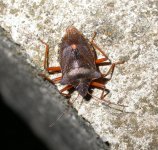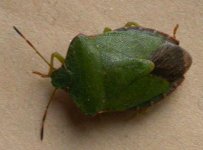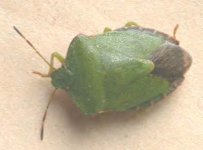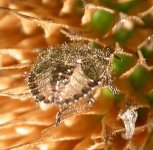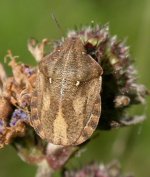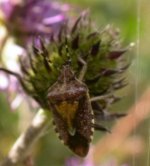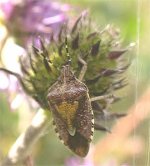-
Welcome to BirdForum, the internet's largest birding community with thousands of members from all over the world. The forums are dedicated to wild birds, birding, binoculars and equipment and all that goes with it.
Please register for an account to take part in the discussions in the forum, post your pictures in the gallery and more.
You are using an out of date browser. It may not display this or other websites correctly.
You should upgrade or use an alternative browser.
You should upgrade or use an alternative browser.
Shieldbugs. (2 Viewers)
- Thread starter Tammie
- Start date
More options
Who Replied?harry eales
Ancient Entomologist
Fuchsia said:Lol Harry - I've got an interesting one this time I think. This bug comes out at night and buzzes around my head while I photograph the moths. It's the noisiest I've ever heard too.
Any idea?
Jen
Hello Jen,
This is one of our regular visitors in the Shieldbug thread. It's a Forest Shieldbug, Pentatoma rufipes. They are very active by day as well as night.
Harry
Last edited:
harry eales
Ancient Entomologist
Fuchsia said:Oh Rats.
Don't you just hate it when people don't read the threads! There it is on just about every page.
I shall try harder next time
Jen :flowers:
Don't worry about it Jen, your not the only one by far. lol. One day I'll get round to posting a series of pictures showing all the commonly met with species. Then you will have no excuse. lol.
Harry :storm:
harry eales
Ancient Entomologist
Angus T said:Well Harry, you expressed an interest in seeing my Green shieldbug. Have seen a few since my original sighting, so took photo off one.
Edit, its strange how the uploaded photo is much darker than the copy on my hard drive
Hello Angus,
I can confirm it is the Green Shieldbug P.prasina. I had hoped it might possibly have been a very similar insect called Petedia juniperina Which supposedly became extinct in Britain in the early 1900's, but which may still occur in some isolated or under-recorded areas, such as Ireland. I have taken the liberty of enhancing your thumbnail (attached). I hope it shows up ok. Thanks for the picture.
Harry
Attachments
steve covey
Jack of all Orders - Master of None
Nymph confirmation please
Hi Harry/all,
only just come across this sticky [I don't live here like you and Ken ]But what a great thread it is. It's spooky that I have just this year got 'into' Shieldbugs, it's the fault of that BBC Wildlife mag article! I've only managed to find and photograph 4 sp. so far this year from visiting sites across Wiltshire: Sloe [everywhere - sorry Harry!]; Green [not too many] Hawthorn [just the one - in my garden] and Dockbug [several sites].
]But what a great thread it is. It's spooky that I have just this year got 'into' Shieldbugs, it's the fault of that BBC Wildlife mag article! I've only managed to find and photograph 4 sp. so far this year from visiting sites across Wiltshire: Sloe [everywhere - sorry Harry!]; Green [not too many] Hawthorn [just the one - in my garden] and Dockbug [several sites].
The main reason for this posting is for this pic - I believe it to be a late instar nymph of the Sloe shieldbug purely because on the same teasel head were several adult Sloe's. Could you confirm this.
Will be getting the Surrey guide when visiting Portland Bill Bird Obs on my annual October pilgrimage.
Cheers,
Steve.
Hi Harry/all,
only just come across this sticky [I don't live here like you and Ken
The main reason for this posting is for this pic - I believe it to be a late instar nymph of the Sloe shieldbug purely because on the same teasel head were several adult Sloe's. Could you confirm this.
Will be getting the Surrey guide when visiting Portland Bill Bird Obs on my annual October pilgrimage.
Cheers,
Steve.
Attachments
harry eales
Ancient Entomologist
steve covey said:Hi Harry/all,
only just come across this sticky [I don't live here like you and Ken]But what a great thread it is. It's spooky that I have just this year got 'into' Shieldbugs, it's the fault of that BBC Wildlife mag article! I've only managed to find and photograph 4 sp. so far this year from visiting sites across Wiltshire: Sloe [everywhere - sorry Harry!]; Green [not too many] Hawthorn [just the one - in my garden] and Dockbug [several sites].
The main reason for this posting is for this pic - I believe it to be a late instar nymph of the Sloe shieldbug purely because on the same teasel head were several adult Sloe's. Could you confirm this.
Will be getting the Surrey guide when visiting Portland Bill Bird Obs on my annual October pilgrimage.
Cheers,
Steve.
Hello Steve,
You're correct it is a Sloe Shieldbug nymph. It's the only Shieldbug species which has hair. You caught it very well in your photograph.
The BBC Magazine arrticle was very poorly illustrated with many of the colours displayed being completely different from those seen in real life.
The Surrey Shieldbug book is excellent was it has detailed 'Keys' and very good photographs of Shieldbugs and larvae, as well as lots of ecological info.
Try a little 'beating' of Oak, Birch and Gorse you should get at least five more species before the end of the month. They will nearly be ready for hibernation then, so you have a little time to find them.
Harry
steve covey
Jack of all Orders - Master of None
Yes, I remember now you mentioning about the hairs in a previous posting. The photo was taken quite late so the sun, at a low angle, back lit the hairs nicely [purely by chance!].
Believe it or not I've not tried beating before as a technique [my main area of interest is Odonata - they don't respond well to beating;0)] Presumably with subjects the size of shieldbugs a proper beating tray isn't a requirement - a bit of old sheet on the ground underneath would do?
Cheers,
Steve.
Believe it or not I've not tried beating before as a technique [my main area of interest is Odonata - they don't respond well to beating;0)] Presumably with subjects the size of shieldbugs a proper beating tray isn't a requirement - a bit of old sheet on the ground underneath would do?
Cheers,
Steve.
harry eales
Ancient Entomologist
steve covey said:Yes, I remember now you mentioning about the hairs in a previous posting. The photo was taken quite late so the sun, at a low angle, back lit the hairs nicely [purely by chance!].
Believe it or not I've not tried beating before as a technique [my main area of interest is Odonata - they don't respond well to beating;0)] Presumably with subjects the size of shieldbugs a proper beating tray isn't a requirement - a bit of old sheet on the ground underneath would do?
Cheers,
Steve.
Hello Steve,
Beating is a very under-rated and seldom used collecting technique these days, which is a pity as it enables a naturalist to find many insects in seconds, that you may otherwise search for, for hours. I always have mine in the back of my van ready for almost instant use, along with sweeping, kite, and pond nets.
A sheet laid on the ground is an awkward way of doing things as wind invariably causes problems. A much more useful item is a golfing umbrella, preferably white in colour. (available from shops like Lydle or even some garages for about £2.99) It's light weight, easy to carry and comes in very handy when there is a sudden change in the weather.
Simply hold the open umbrella in an inverted position under the bush or branch of the tree you wish to sample and hit the branch or stem once
with a hard blow with a stout piece of wood. Flogging away will not add any more specimens and will just cause damage to the tree or shrub. If you beat Gorse, wear a stout pair of gardening or industrial gloves otherwise you will spend half your day pulling spines out of your hands.
Remove any debris, leaves, etc., and examine the contents of your 'tray', you will be very surprised just how much there is, in the way of insect and other life forms. Certainly you will have many subjects to choose from if your into photography.
If you put the specimens into 2" x 1" specimen tubes and then into a small 'chiller' box for a few minutes, the coldness will slow them down and then they can be placed onto a leaf or twig where they will remain imobile for a minute or so, while they 'warm up'. This will give you time to 'set up' your picture. Afterwards they can be left to get on with their lives.
Beating trays are quite expensive to purchase from dealers and can easily be made at home it your handy with a few tools. My own tray is home made and constructed of aluminium tube and nylon rod framework and a washable cloth tray. It can be assembled in 30 seconds. Its total weight is 8oz. and that includes the beating stick as well.
Try the umbrella method first, you'll soon be hooked on this method of finding insects.
Harry
steve covey
Jack of all Orders - Master of None
That sounds like great fun Harry and as you say probably quite addictive. I'll be scouring the stores for a white brolly tomorrow!
I'd better limit myself to my current interests however, as if I start studying all of the mass of wildlife which is likely to 'rain' into the brolly/tray I'll have to give up work entirely;0)
Cheers,
Steve.
I'd better limit myself to my current interests however, as if I start studying all of the mass of wildlife which is likely to 'rain' into the brolly/tray I'll have to give up work entirely;0)
Cheers,
Steve.
harry eales
Ancient Entomologist
steve covey said:That sounds like great fun Harry and as you say probably quite addictive. I'll be scouring the stores for a white brolly tomorrow!
I'd better limit myself to my current interests however, as if I start studying all of the mass of wildlife which is likely to 'rain' into the brolly/tray I'll have to give up work entirely;0)
Cheers,
Steve.
I did Steve,
I retired at 55 and have spent the last six years getting paid for doing insect surveys. Whilst it's not in the millionaire bracket of wages, I manage quite well on what I get. What other job will get you out into the great outdoors for at least nine months of the year, letting you do what you enjoy most, yet allow you to be snug and warm during the coldest three months. lol.
Harry
steve covey
Jack of all Orders - Master of None
I like the sound of that Harry - where do I sign upharry eales said:I did Steve,
I retired at 55 and have spent the last six years getting paid for doing insect surveys. Whilst it's not in the millionaire bracket of wages, I manage quite well on what I get. What other job will get you out into the great outdoors for at least nine months of the year, letting you do what you enjoy most, yet allow you to be snug and warm during the coldest three months. lol.
Harry
Although I enjoy what I do now as a membership recruiter, it can get quite frustrating and depressing at times trying to persuade people to even stop and listen, let alone convince them to sign up to the wildlife trust.
I'm not a great people person [sounds a daft thing to say I know given the line of work I'm in] and far prefer to be in the countryside immersed in nature - wildlife is generally far more honest and uncomplicated!
Oops! getting a bit profound here, must be this weather getting to me a bit :-C
Cheers,
Steve.
Michael Gilmore
Registered User
Hi,Tammie said:Hello Forum,
I was wondering if anyone could tell me what this strange looking bug is. It looks like it's almost armour plated. I see them everywhere around here but spotted this one sitting on the edge of my window feeder. Any ideas out there? Thanks!
Yes it's a shield-bug, harmless but they are the insect equivalent of skunks in Europe, known as stink-bugs in France, that's a rough translation of the vulgar French word for them!
Mike Gilmore
steve covey
Jack of all Orders - Master of None
Tortoise bug ?
Hi all [especially Harry ]
]
Just seen a new species of Shieldbug [for me anyway] today at Somerford Common. I'm pretty sure its a Tortoise bug Eurygaster testudinaria even though it's not a perfect match for the inadequate BBC Wildlife mag illustrations - which is all I have to go on for now.
Could this be confirmed for me please.
Cheers,
Steve.
Hi all [especially Harry
Just seen a new species of Shieldbug [for me anyway] today at Somerford Common. I'm pretty sure its a Tortoise bug Eurygaster testudinaria even though it's not a perfect match for the inadequate BBC Wildlife mag illustrations - which is all I have to go on for now.
Could this be confirmed for me please.
Cheers,
Steve.
Attachments
steve covey
Jack of all Orders - Master of None
And another one...
Here's another one from the same site which I at first thought was a Sloe shieldbug, but I now think it's a Forest bug. This will be another new one for me.
Interestingly they all seem to be 'nectaring' on the dead looking flower heads of Devil's-bit Scabious!?
Cheers,
Steve.
Here's another one from the same site which I at first thought was a Sloe shieldbug, but I now think it's a Forest bug. This will be another new one for me.
Interestingly they all seem to be 'nectaring' on the dead looking flower heads of Devil's-bit Scabious!?
Cheers,
Steve.
Attachments
harry eales
Ancient Entomologist
steve covey said:Hi all [especially Harry]
Just seen a new species of Shieldbug [for me anyway] today at Somerford Common. I'm pretty sure its a Tortoise bug Eurygaster testudinaria even though it's not a perfect match for the inadequate BBC Wildlife mag illustrations - which is all I have to go on for now.
Could this be confirmed for me please.
Cheers,
Steve.
Hello Steve,
Your spot on with your ID, it is E.testudinaria. This is the first time it has appeared in this thread.
The BBC Wildlife Mag is rather poor as far as illustrations are concerned.
The Field Studies Council's AIDGAP series has a Guide to the Shieldbugs of the British Isles (8 page folded and laminated chart) is considerably better and cheaper than a copy of the BBC Magazine, but even this leaves a little to be desired in picture quality, although it also has illustrations of some closely related bugs (Coreidae) as well.
By far the best quality ID book on the market is The Shieldbugs of Surrey by Roger D. Hawkins. 192 pages, excellent keys and the best Shieldbug photo's I have ever seen. At £15 for a hardback book it's excellent value.
Harry
harry eales
Ancient Entomologist
steve covey said:Here's another one from the same site which I at first thought was a Sloe shieldbug, but I now think it's a Forest bug. This will be another new one for me.
Interestingly they all seem to be 'nectaring' on the dead looking flower heads of Devil's-bit Scabious!?
Cheers,
Steve.
First impressions are sometimes best Steve. It is a Sloe bug. D.baccarum. What it is doing is feeding from the unripened seeds, from which it sucks the juices. A good number of Shieldbug species do this.
I have taken the liberty of adjusting your picture to make it more visible.
A word of caution here, at this time of year many Shieldbugs change colour prior to hibernation so you may see some oddly coloured specimens in the next few weeks.
Edit, Steve if you have a look at post 161 in this thread you will see an excellent shot of the Forest Bug. P.rufipes taken by Fuchia. Note the overall colour, the red spot on the scutellum the red legs and the blunt, squared off shoulders. It is a very common species and easily obtained by beating Oak, Hawthorne, Birch and other trees and shrubs.
Harry
Attachments
Last edited:
steve covey
Jack of all Orders - Master of None
|:$| Thanks for both determinations Harry - it was the top of the 'shield' which threw me as it wasn't clean lines like in other specimens of Sloe that I've seen. I ought to have thought of Autumn colour change as I already knew that it happens with Green Shieldbug and, of course, the lack of red legs etc should have sent alarm bells. Still it's early days for studying this group and it's good to make a few mistakes - you remember the id features better in the futureharry eales said:First impressions are sometimes best Steve. It is a Sloe bug. D.baccarum. What it is doing is feeding from the unripened seeds, from which it sucks the juices. A good number of Shieldbug species do this.
I have taken the liberty of adjusting your picture to make it more visible.
A word of caution here, at this time of year many Shieldbugs change colour prior to hibernation so you may see some oddly coloured specimens in the next few weeks.
Edit, Steve if you have a look at post 161 in this thread you will see an excellent shot of the Forest Bug. P.rufipes taken by Fuchia. Note the overall colour, the red spot on the scutellum the red legs and the blunt, squared off shoulders. It is a very common species and easily obtained by beating Oak, Hawthorne, Birch and other trees and shrubs.
Harry
Your comments about their feeding techniques is very interesting [and I'll resist making some joke including 'sucks seeds' :'D As well as scabious I've seen them behaving the same way on teasel and thistle.
I'm hoping to spend a few days during the 3rd week of October at Portland Bill Bird Obs. and hope to purchase both the book and the AIDGAP at their excellent wildlife bookshop [plug, plug!] The AIDGAP key will be useful to carry in the field - I already use their Orthoptera one.
Still can't find a white umbrella anywhere - may have to resort to a golfpro shop but usually dear there!
Cheers,
Steve.
harry eales
Ancient Entomologist
Hello Steve,
You'll soon get into the swing of ID'ing the larger species, the only problem you may come across is separating the Birch Shieldbug from the Juniper Shieldbug, but once you know they can be separated by the length of the basal segment of the antennae you will have no further problems. In southern England the Juniper SB is spreading rapidly, since it has adapted to live on cone bearing Lawsons Cypress.
Your luckier than me, living where you are, there are a lot more species of SB down south than there are up here.
It's not absolutely necessary to find a white umbrella, yellow or light green will so as a temporary stop gap until you get a proper beating tray.
Harry
You'll soon get into the swing of ID'ing the larger species, the only problem you may come across is separating the Birch Shieldbug from the Juniper Shieldbug, but once you know they can be separated by the length of the basal segment of the antennae you will have no further problems. In southern England the Juniper SB is spreading rapidly, since it has adapted to live on cone bearing Lawsons Cypress.
Your luckier than me, living where you are, there are a lot more species of SB down south than there are up here.
It's not absolutely necessary to find a white umbrella, yellow or light green will so as a temporary stop gap until you get a proper beating tray.
Harry
Users who are viewing this thread
Total: 3 (members: 0, guests: 3)




